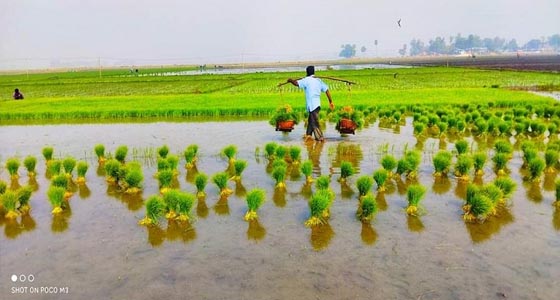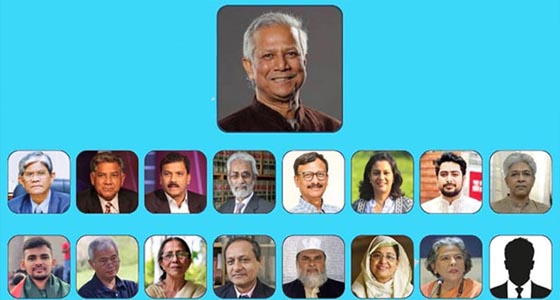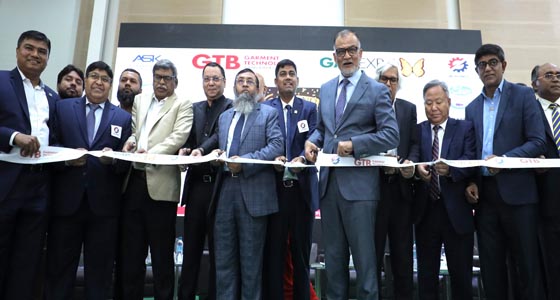Focus on agriculture and welfare of farmers
- Last Update : 03:01:02 pm, Tuesday, 20 August 2024
- / 798 Read Count
Shamiran Biswas
As it is true that Bangladesh is a small but populous country in the world, it is also recognized globally as a rich country in crop production. At this time of day, the whole world is getting ready. And these reasons are; Discrimination, corruption, war, climate change and various epidemics that are killing the society, the country. The harmful effects of climate change have been going on in Bangladesh and around the world for the past few years.
According to the World Food Organization (FAO), 45 countries in the world are now at the highest risk of severe food insecurity due to shortages. Among them, there are nine countries belonging to the Asian continent, of which three countries, including Bangladesh, belong to South Asia. According to FAO’s calculations, global food grain production will decrease by 1.4 percent this year. Bangladesh will not be left out. And taking these aspects into consideration, the relevant ministries of the interim government should take effective steps and programs to keep the production plan of Bangladesh going.
Bangladesh has a total of 1.61 million cultivated land and 8.629 thousand hectares of arable land. Out of that, the amount of eligible fallow land is like 4 lakhs 32 thousand hectares. It is noteworthy here that if this arable land can be brought under our control, it will play a role in dealing with our food crisis, as well as it will be fruitful in rural socio-economic development.
Bangladesh has about 253.60 lakh homesteads, covering 5.40 lakh hectares. The average size of homesteads in the country is 0.02 hectares. The number of farmer families is 165.62 lakh and the amount of cultivable fallow land is 2.23 lakh hectares. In order to bring these lands under cultivation, it is very important to bring the fallow land of the government’s Department of Agriculture under cultivation and to bring homesteads under the cultivation of various vegetables.
The hills also have a lot of fallow land. A survey by the Ministry of Agriculture shows that at least 5 lakh hectares of land is lying uncultivated in the three hill districts of Rangamati, Khagrachari and Bandarban. There are unused lands of Bangladesh Railways, government educational institutions, parks, libraries, religious places of worship which can be easily brought under plantation. Apart from this, a very popular work can be done by gardening on the roof of the homestead. Also, now is the time to make agriculture sustainable and modern by increasing the use of modern agricultural machinery and incorporating artificial intelligence technology in agriculture through good agricultural practices.
Agricultural inputs (fertilizers, seeds, pesticides, irrigation, fuel oil) to increase the cultivation and production of Boro paddy, wheat, maize, mustard, sunflower, groundnut, winter mung, winter vegetables, onion etc. in Rabi season in the coming year 2023-24 , power and agricultural credit) support and ensuring access is essential.
BRRI high yielding modern rice variety is currently cultivated in 82% of Boro (winter rice), 36% of Ausher (summer) and 47% of Ropa Aman (monsoon) area of the country. Presently 75% of the total land of the country is cultivated with BRRI rice and it accounts for 85% of the total rice production of the country. The high yielding modern variety of BRRI for the coming Boro season is playing a key role in increasing paddy production every year. Therefore, it is high time that the relevant Ministry of Agriculture of the Interim Government of Bangladesh should give maximum consideration and attention to the welfare of agriculture and farmers for the successful production of paddy in the coming Boro season.
Good Agricultural Practices (GAP) are; Holistic agricultural activities, leading to safe and quality food production and availability of non-food agricultural products, environmental protection, economic and social cohesion. By giving the highest priority to safe food production, Bangladesh will strengthen Bangladesh’s agriculture through safe food production and export of food products through the principles of good agricultural practices. To ensure safe and quality food from the farm stage to the consumer stage, implementation of Good Agricultural Practices (GAP) in on-farm production and post-production processes is crucial.
If agriculture survives, the people of the country will be able to survive, the current interim government must realize this with utmost importance. In the World Economic Outlook report published last October, the IMF said that the global economy may face a severe recession in 2023-24. At present, the Bangladesh government as well as the agricultural adviser has to take into consideration the importance of agriculture as a whole, agricultural development and the welfare of farmers, there is no alternative.
The writer is a, Agriculture and Environment Specialist, Dhaka.

















